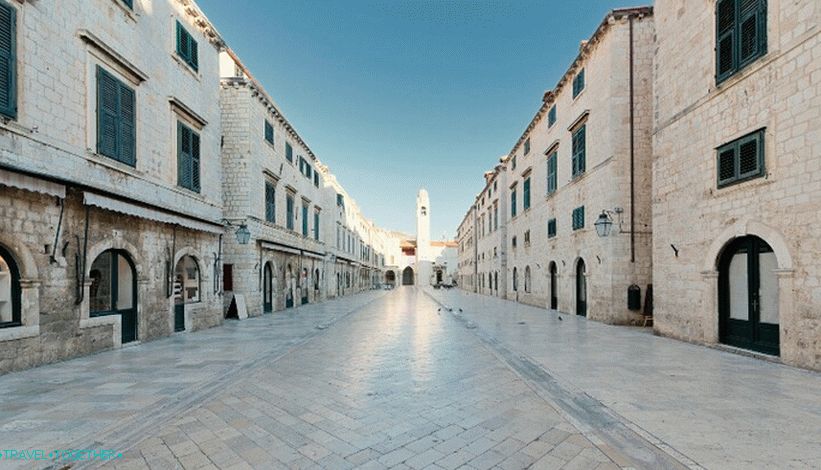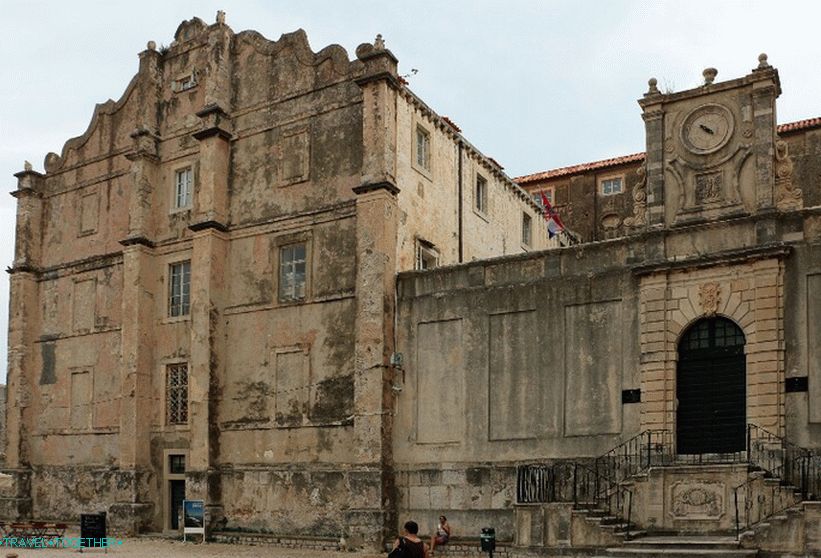Dubrovnik (Croatia) – detailed information about the city from a photo. The main attractions of Dubrovnik with a description, guides and maps.
Contents
City Dubrovnik (Croatia)
Dubrovnik – a city in the south of Croatia in the historical region Dalmatia. Located on the Adriatic Sea and is the center of the Dubrovnik-Neretva County. Dubrovnik – one of most beautiful cities in Southern Europe, often called “the pearl of the Adriatic” or “Slavic Athens.” Most interesting its feature is a stunning old town surrounded by a ring of fortress walls with a labyrinth of atmospheric narrow streets and old buildings with red tiled roofs. Historical Center Dubrovnik is listed as a UNESCO World Heritage Site and received wide acclaim through the series “The Game Thrones. ”
Dubrovnik is one of the oldest and most important cities Croatia It was founded in the 7th century and throughout its history has been major shopping and cultural center, sea port. AT The Middle Ages Dubrovnik was the only city that vied with Venice for supremacy in the Adriatic. In addition, the city was one of the development centers of the Croatian language and literature. Now Dubrovnik is the most popular resort and seaport, a city with rich in history and stunning architecture, impressive churches, monasteries, museums and fountains.
 Old city Dubrovnik
Old city Dubrovnik
- Geography and climate
- Best time to visit
- Practical information
- Story
- How to get there
- Shopping and shopping
- Food and drink
- sights
- Video
- Maps and guides
- Comments and reviews
Geography and climate
Dubrovnik is located in the extreme south of Croatia on the Adriatic sea. The climate is warm subtropical. Average annual temperature is over 16 degrees. The temperature of the coldest month (January) about 9 degrees with a plus sign. Summer actually lasts with May to October.
 Panorama old town
Panorama old town
Best time to visit
The best time to visit Dubrovnik depends on your goals. If the main thing is the desire to touch it attractions and culture, it is best to choose the off season. The beach season here lasts from May to October. Summer (especially July and August) – the peak of the tourist season. Therefore, for a beach holiday, with In terms of economy and comfort, it is better to use May-June and September October.
Practical information
- The population is more than 42 thousand people.
- The area is 143.35 square kilometers.
- The language is Croatian.
- Currency – Kuna.
- Visa – Schengen.
- Time – Central European UTC +1, in summer +2.
- Dubrovnik is a fairly safe city. Must comply elementary security measures. Also when walking around the city you need wear comfortable shoes, as cobbled streets can be quite slippery.
 Beach in Dubrovnik
Beach in Dubrovnik
Beaches
The most famous beaches of Dubrovnik:
- Lapad is one of the most famous beaches of the Adriatic. This sandy The beach is located 3.5 km from the old town.
- Banje – pebble beach near the historic center with scenic view of dubrovnik.
- Buza – a small beach on the rocky slopes in the southern part Dubrovnik (right under the ancient walls). You can get there through a small door behind the cathedral.
- Beach of sv. Jacob – located in a secluded place 1.5 km from Dubrovnik.
- The beaches of Lokrum Island are relatively quiet wild beaches. You can get there by ferry or boat.
Story
The first settlement was founded on a small island in the 7th century on rocky shore. It quickly grew to a city that inhabited by Slavs and representatives of the Romance peoples. Mixed the population most likely spoke Dalmatian. Ancient The settlement existed according to the type of the Greek polis. In the 10th century here a catholic diocese was formed. Around the same time was built a fortress to protect access to the island.
At that time, the settlement was called Ragusa. Until the 10th century the city was influenced by Byzantium, retaining a certain independence. In 1000, ancient Ragusa swore at Venice. AT 12th century bay separating the island from the mainland fell asleep. In its place was formed Stradun Street. City was surrounded by walls, which were rebuilt before the 17th century.
 Streets old cities
Streets old cities
Since the 12th century, Dubrovnik has become one of the main shopping centers. Adriatic, gaining greater independence. In 1205, he again was occupied by Venice. Under the rule of the Venetians the city was over 150 years. In 1358 Dubrovnik was formed republic, which was under some influence of Hungary. Despite the claims of Venice and the threat from the Turks, the republic retained its independence, reaching a large heyday.
In 1667 a strong earthquake significantly damaged Dubrovnik. From the end of the 16th century begins a gradual decline. of the republic. Interestingly, since the 13th century Dubrovnik has never been taken by storm. In 1806, Napoleon’s troops entered the city and independence Dubrovnik has stopped. After a short French domination, Dubrovnik became part of the Habsburg Empire. Under authority Austria, the city was located until the end of the First World War.
 Panorama Dubrovnik
Panorama Dubrovnik
After 1918, Dubrovnik became part of the future Yugoslavia. The historic center of the city suffered in 1991-1995 during war in Croatia after the declaration of its independence.
How to get there
Dubrovnik Airport is located 20 km south of the historic center. Most airlines operate seasonal flights. In season fly to Dubrovnik from Moscow, Dublin, Stuttgart, Munich, London, Milan, Dusseldorf, Rome, Vienna, Madrid, Berlin, Hamburg, Oslo, Stockholm, Helsinki, Prague, Istanbul, Barcelona. Buses and taxis run to the city from the airport.
Dubrovnik does not have access to the railway. Closest major railway station is located in Split. Main bus station located 2.5 km from the old town. Direct bus routes connect Dubrovnik with Zagreb, Sarajevo, Split, Rijeka.
 Panorama Dubrovnik
Panorama Dubrovnik
Shopping and shopping
In the old town there are many shops selling as local artisans and traditional products clothes and shoes of famous brands. Basically, in Dubrovnik buy wine and other local products, textiles (handmade tablecloths, bed linen), ties (which the Croats believe came up it is in their country).
Food and drink
In the historic center of Dubrovnik there are many cafes and restaurants that offer about the same menu with a large number of fish and seafood dishes. Despite the fact that the kitchen it is not very diverse, it is of good quality, delicious, using only fresh ingredients. Here also You can find good pizzerias with wood-burning stoves, in which pizza is not worse than in Italy.
 Panorama of the city
Panorama of the city
The most popular strong alcoholic drink in Croatia is rakia. Very good taste Croatian wine. Also have good beer. Bars and clubs are concentrated in the vicinity of the street Stradun
sights
The main attraction of Dubrovnik is charming old town surrounded by walls and listed as a UNESCO World Heritage Site. The historical center mainly belongs to the 13th century and is a labyrinth of narrow atmospheric streets, where among ancient houses scattered numerous monuments of history and culture, museums and galleries.
 Walls Dubrovnik
Walls Dubrovnik
The most interesting feature of the historic center is fortress walls, which have a length of almost 2 km and completely surround the old city. Construction of the first urban The fortifications were begun in the 10th century and continued until the 17th century.
 Walls Dubrovnik
Walls Dubrovnik
These formidable walls are 6 meters high and stand on a picturesque rocky shore. For a fee, you can climb the walls and enjoy magnificent views of Dubrovnik and the Adriatic. The entrances are located with side of stradun and near the fort of st. John Also the city walls of Dubrovnik include several fortified forts and towers
 Street stradun
Street stradun
Stradun – the main street of Dubrovnik, which is considered one of the most picturesque pedestrian streets of Europe. The story of this white The pavement dates back to 1468, although many of the surrounding buildings were built in the 17th century after the devastating earthquake of 1667 of the year.
 Square Lodge
Square Lodge
Lozha Square – one of the central squares of Dubrovnik in Venetian style. Located in the northeastern part of the old cities. Roland’s Column (Orlando) is installed on the square, carved in 1417. Here is the famous Loggia bells dating from 1480 and used as a system early warning residents.
 Square Lodge
Square Lodge
On the square there is a beautiful baroque church of st. Vlakha, dedicated to the patron saint of the city. Built in the 18th century on the site of an ancient Romanesque church that survived earthquake of 1667, but was destroyed later by a fire. Building It was built according to the design of a Venetian architect and has a rich decorated baroque facade.
There is also a 15th century tower and a small fountain. At the top of the tower are the famous bronze statues, who beat the big bell every hour.

Cathedral of the Assumption of the Blessed Virgin Mary – Grand Baroque Cathedral 18th century, designed by Roman architect Andrea Buffalini. it the third religious building built on this site. Already at 7 century the first basilica was built here, rebuilt in the 14th century and destroyed by an earthquake in 1667. Remnants of both early churches can still be seen in the structure of the current cathedral. Temple It is known for its three portals, three apses and a magnificent internal decor that includes paintings of Italian and Dalmatian artists 16-17 centuries, including the masterpiece of Raphael. Treasure chest Cathedral contains precious Christian relics such as the cross on which Christ was crucified, and the relics of St. Vlaha.
 Gate saw
Gate saw
Pile Gate – the famous Renaissance city gate, built in 1537 and served as the main entrance to the city. Earlier the gate had a drawbridge and was protected by a moat. In a niche located sculpture carved by the famous Croatian artist Ivan Mashtrovichem. In the walls there is a door that refers to the year 1460.
 Ploce Gate
Ploce Gate
Ploce Gate – 14th century city gate, designed as double protection system.
 Big fountain
Big fountain
The big fountain is one of the most famous sights. Dubrovnik, built between 1438 and 1444 years. He was decorated many sculptures damaged by an earthquake in 1667. There are 16 carved masks left from which water flows.
Close to beautiful gothic and renaissance mansions there is a small Savior church built in the 16th century and survived this earthquake.
 Rector’s Palace
Rector’s Palace
Rector’s Palace – a magnificent old palace in the style of late Gothic and early renaissance, built in 1435. Here now there is a museum detailing the life in Ragusa in medieval times.
 Fort of sv. John’s
Fort of sv. John’s
Fort of sv. John – fortification on the eastern edge of the old city, one of its most important defensive structures. In its walls is located Maritime Museum. The fort was laid in the 14th century and in the 16th century incorporated into Dubrovnik defensive system. Also nearby is a fort. Bokar
 Lovrienac
Lovrienac
Lovrienac is an impregnable medieval fortress located on a 37-meter cliff near the western wall. This is one of the most important strongholds of Croatia, which was completed in the 11th century. Fort known for its unusual triangular layout, powerful walls and that was unapproachable during many sieges. To the fortress there are two drawbridges.
 Synagogue
Synagogue
The synagogue is one of the oldest synagogues in Europe, which houses ancient jewish artifacts.
 Sponza Palace
Sponza Palace
Sponza Palace – the Gothic palace of the Renaissance.

Church of sv. Ignatia – exquisite Jesuit church built between 1667 and 1725 by architect Ignazio Pozzo. Beside there is a beautiful baroque staircase built by modeled on the famous Spanish in Rome.
 Dominican monastery
Dominican monastery
Dominican monastery was founded in 1315 and is located near the gate Ploce. Inside there is a beautiful gothic abode and valuable works of art (including works by Titian and Raphael).
 Franciscan monastery
Franciscan monastery
Franciscan Monastery is a 14th century abbey that includes Europe’s oldest pharmacy (opened in 1317).
Video
Maps and guides
City map






